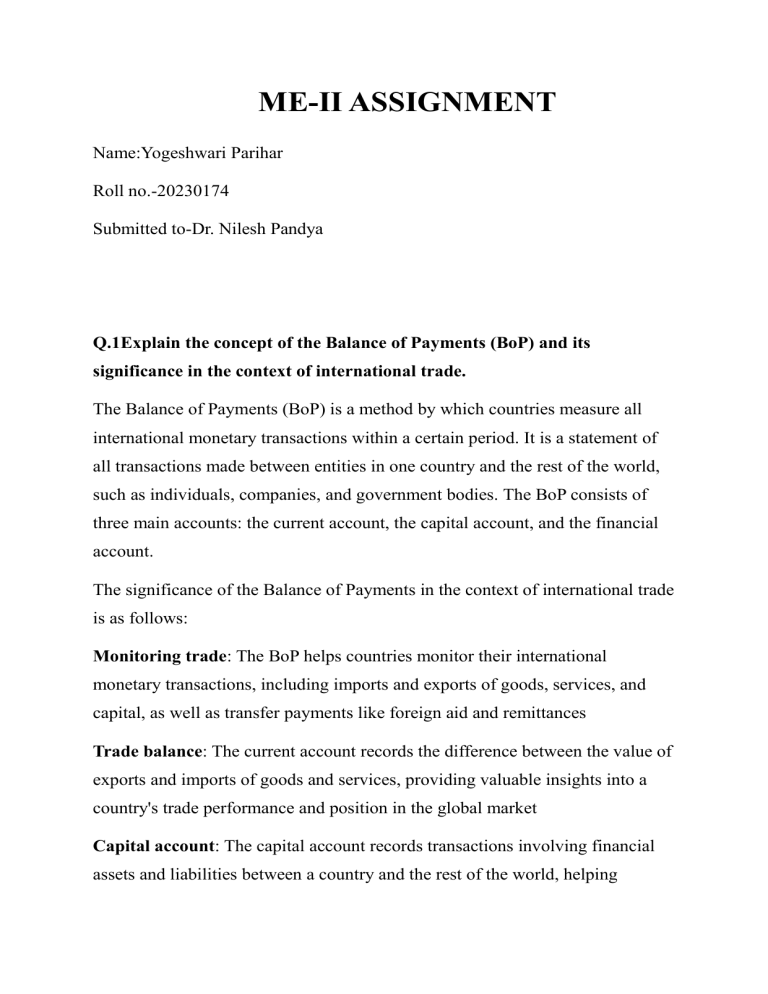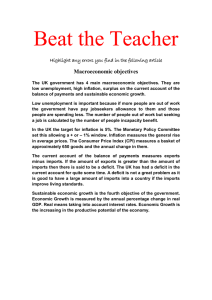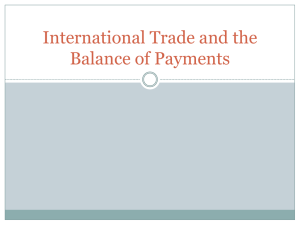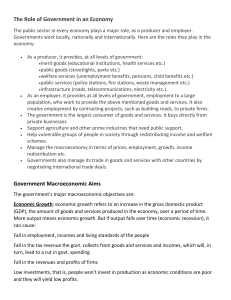
ME-II ASSIGNMENT Name:Yogeshwari Parihar Roll no.-20230174 Submitted to-Dr. Nilesh Pandya Q.1Explain the concept of the Balance of Payments (BoP) and its significance in the context of international trade. The Balance of Payments (BoP) is a method by which countries measure all international monetary transactions within a certain period. It is a statement of all transactions made between entities in one country and the rest of the world, such as individuals, companies, and government bodies. The BoP consists of three main accounts: the current account, the capital account, and the financial account. The significance of the Balance of Payments in the context of international trade is as follows: Monitoring trade: The BoP helps countries monitor their international monetary transactions, including imports and exports of goods, services, and capital, as well as transfer payments like foreign aid and remittances Trade balance: The current account records the difference between the value of exports and imports of goods and services, providing valuable insights into a country's trade performance and position in the global market Capital account: The capital account records transactions involving financial assets and liabilities between a country and the rest of the world, helping countries understand their net inflow or outflow of capital and its impact on their economic stability Performance evaluation: BoP data can be used to assess a country's performance in international trade, allowing policymakers to identify areas for improvement and develop strategies to address imbalances, such as promoting exports or implementing exchange restrictions In essence, the BoP acts as a financial report card for countries, offering a snapshot of their economic health and providing valuable insights into their position in the global market By analyzing the BoP, governments, businesses, and researchers can make informed decisions and develop strategies to improve their country's economic performance and trade relationships. Q.2. Provide a detailed analysis of the components of the BoP, including the current account and capital account. The Balance of Payments (BoP) is a comprehensive record of all international monetary transactions made between a country and the rest of the world within a specific period. It consists of three main accounts: the current account, the capital account, and the financial account. Here's a human-friendly explanation of these components: 1. Current Account: The current account records the value of exports and imports of goods and services, international transfers of capital, and net income from abroad. It is an important indicator of an economy's speed and includes the following components: Trade Balance: The difference between the value of exports and imports of goods and services. Net Income from Abroad: Earnings on foreign investments minus payments made to foreign investors. Net Transfer Payments: Such as foreign aid and remittances. 2. Capital Account: The capital account records all transactions made between entities in one country with entities in the rest of the world. It measures the changes in national ownership of assets and includes transactions involving financial assets and liabilities between a country and the rest of the world. This account can indicate whether a country is a net importer or net exporter of capital and provide clues about its relative level of economic stability and attractiveness to foreign investors. In summary, the BoP's current account tracks a country's trade balance, income from abroad, and transfer payments, while the capital account records transactions related to a country's ownership of assets and its import or export of capital. These components together provide a comprehensive view of a country's international financial transactions and its economic health. Q.3. Discuss how a trade surplus or deficit can impact a country's economy and what policy measures can be implemented to address such imbalances. A trade surplus occurs when a country's exports of goods or services exceed its imports, while a trade deficit occurs when a country imports more than it exports. According to the data provided India had a trade deficit in the years 2017-18, 2018-19, and 2019-20 The deficit in the merchandise trade was significant, with the value of imports exceeding the value of exports by a large margin This trade deficit can have significant impacts on India's economy, including: 1. Currency value: The trade deficit can weaken India's currency in the global markets, making imports more expensive and exports cheaper 2. Employment: The trade deficit can lead to job losses in certain sectors, as imports replace domestic products. 3. Investment: The trade deficit can reduce investment in research and development, thereby undermining productivity growth and contributing to the stagnation of incomes. Policy measures that can be implemented to address the trade imbalance include: Export promotion: The government can promote exports by providing subsidies and incentives to export-oriented industries Import substitution: The government can encourage domestic production of goods that are currently being imported, thereby reducing the trade deficit Tariffs and import duties: The government can impose tariffs and import duties on goods that are being imported in large quantities, thereby reducing imports and addressing the trade imbalance Foreign investment: The government can attract foreign investment to boost domestic production and exports Exchange rate management: The government can manage the exchange rate to make exports more competitive and reduce imports.



